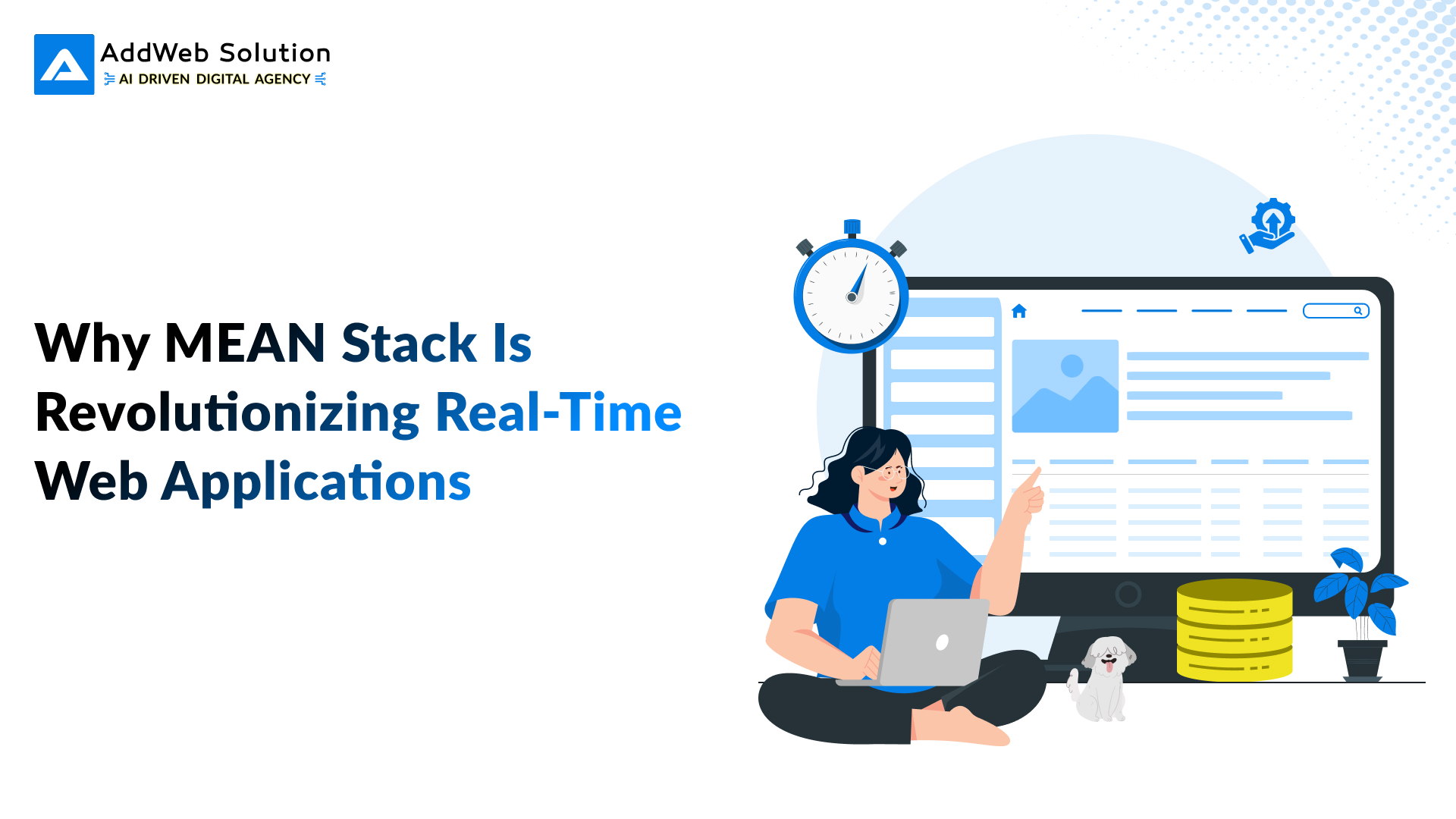Real-time interactions have become essential for modern web applications in the fast-paced digital world. Whether they are real-time messaging, collaborative document editing, financial dashboards, or online gaming, users expect instant updates and seamless performance.
To meet these demands, developers need a technology stack that delivers speed, scalability, and efficiency in one unified environment.
Enter the MEAN stack—a powerful combination of MongoDB, Express.js, Angular, and Node.js—which has redefined real-time web application development. By leveraging JavaScript across the entire stack, MEAN simplifies development, reduces latency, and ensures seamless data synchronization.
With its event-driven, non-blocking architecture, the MEAN stack is the go-to choice for building high-performance applications capable of handling massive user interactions.
As businesses prioritize real-time capabilities, the MEAN stack remains a game changer. It enables developers to create scalable, interactive, and efficient web applications quickly. Let’s explore how the MEAN stack is shaping the future of web development.
The Rise of MEAN Stack in Real-Time Web Development
Modern web applications demand instant data updates and high concurrency. Whether messaging apps, live collaboration tools, or stock market dashboards, traditional development stacks often struggle with scalability and responsiveness.
The MEAN stack, however, provides an event-driven, non-blocking framework that ensures high performance, even under heavy traffic loads.
Key Strengths of MEAN Stack for Real-Time Applications
- Node.js for Asynchronous Processing—With its event-driven, single-threaded model, Node.js handles thousands of simultaneous requests without delays. According to Pixel506, It can efficiently manage thousands of concurrent connections.
- MongoDB for Real-Time Data Syncing – Unlike traditional relational databases, MongoDB’s NoSQL architecture allows dynamic scaling and real-time data processing, ensuring low-latency performance.
- Angular for Seamless Frontend Interactivity: Angular provides two-way data binding, allowing instant UI updates in response to backend changes. Thus, it is ideal for interactive applications.
- Express.js for Efficient API Handling – Express.js enables smooth communication between the front and back, making it easier to develop real-time APIs.
These features make MEAN an ideal choice for applications that require instant updates and smooth user interactions.
Real-Time Cases of MEAN Stack
MEAN stack has been widely adopted for real-time applications across industries. Some everyday use cases include:
1. Real-Time Chat Applications
Platforms like WhatsApp and Slack rely on Node.js and WebSockets to provide instant messaging with minimal latency. MEAN’s non-blocking architecture makes it perfect for handling concurrent chat users.
2. Live Collaboration Tools
Tools like Google Docs and Trello require real-time updates as multiple users edit a document simultaneously. Angular’s two-way data binding and MongoDB’s real-time sync enable seamless collaboration.
3. Streaming & Entertainment Platforms
Netflix and YouTube use MEAN stack components to deliver real-time video streaming experiences. MongoDB handles metadata and user preferences efficiently, while Node.js ensures fast server responses.
4. Financial & Stock Market Applications
Stock trading platforms like Robinhood and E-Trade rely on real-time market data. MongoDB’s ability to process large volumes of data and Node.js’s event-driven architecture enable instant updates on stock prices.
5. Ride-Sharing & Logistics Applications
Companies like Uber and Lyft use MEAN stack technologies to provide real-time ride tracking and driver-rider matching, ensuring seamless booking and navigation.
MEAN Stack & Microservices Architecture
Microservices architecture is increasingly adopted for scalable and modular application development. MEAN stack complements microservices by enabling independent, lightweight services that can communicate efficiently.
Why does MEAN Stack fit well with microservices?
- Scalability: MEAN’s modular design allows services to be scaled independently.
- Faster Deployment: Microservices break down applications into smaller, manageable components, reducing time to market.
- API-Driven Communication: Express.js simplifies REST API development for seamless microservice interactions.
- Event-Driven Execution: Node.js’s non-blocking nature is ideal for event-driven microservices processing.
For instance, an e-commerce platform powered by the MEAN stack can use microservices to manage inventory, payments, and user authentication separately.
Why does MEAN Stack stand out?
One of the primary reasons developers favor MEAN is its ability to provide a full-stack JavaScript environment. Unlike traditional stacks that require multiple languages for frontend and backend, MEAN enables developers to use JavaScript throughout the entire development process, resulting in:
Benefits of MEAN Stack for developers & businesses
- Faster Development Cycle—Since JavaScript is used across the entire stack, developers can seamlessly transition between the front and back end. This reduces development time, minimizes compatibility issues, and enhances team collaboration.
- High Scalability—MongoDB’s horizontal scaling allows applications to adjust resources dynamically based on demand. MongoDB distributes data across multiple servers as user traffic increases, ensuring optimal performance and uptime.
- Cost-Effectiveness—The MEAN stack comprises open-source technologies, eliminating the need for expensive licenses. Thus, businesses can build high-performance applications without worrying about licensing fees, making it a budget-friendly option.
- Cloud Compatibility—MEAN is designed for modern cloud-based applications. It seamlessly integrates with cloud services like AWS, Google Cloud, and Microsoft Azure, enabling businesses to deploy and scale their applications efficiently.
- Code Reusability—JavaScript is used on both the client and server sides, allowing developers to reuse code modules. This reduces redundancy and improves efficiency, leading to cleaner code and faster deployment.
According to a Stack Overflow survey, MEAN stack technologies consistently rank among the most popular full-stack development choices, further validating their industry-wide adoption.

Optimize Smarter with Generative Engine Optimization.

Pooja Upadhyay
Director Of People Operations & Client Relations
MEAN Stack in Action: Real-World Applications
Many leading companies use the MEAN stack to power their real-time applications. Let’s explore some prominent use cases:
Industry leaders utilizing MEAN Stack
- LinkedIn – Uses Node.js to handle millions of real-time updates, resulting in 20x faster performance than its previous Ruby-based system. The transition helped optimize resource utilization and user experience.
- PayPal – Migrated to Node.js and achieved a 35% reduction in response time while doubling the number of requests per second. This improved transaction processing efficiency and enhanced scalability.
- Netflix – Employs Node.js for server-side rendering, ensuring ultra-fast content delivery to millions of global users—the shift to MEAN enhanced load management and reduced latency.
- Trello relies on Node.js for real-time collaboration. It allows users to edit boards and lists simultaneously without lag, making it highly responsive and interactive for project management.
- Uber – Uses Node.js for real-time tracking and seamless ride-booking, handling millions of user requests daily. The asynchronous nature of Node.js enables quick processing of driver and rider requests.
Additionally, finance, e-commerce, healthcare, and social media also leverage MEAN for fast, scalable, and interactive applications.
Security Considerations in Real-Time Applications
Security is a critical aspect of real-time web applications. While the MEAN stack offers built-in security features, additional measures enhance protection:
Key security strategies
- Authentication & Authorization – Implementing secure authentication protocols such as JWT (JSON Web Tokens) or OAuth ensures that only authorized users can access resources.
- Data Encryption – Sensitive data stored in MongoDB should be encrypted using AES-256 encryption to prevent unauthorized access.
- Rate Limiting – Enforcing API rate limits in Express.js helps protect applications from DDoS attacks and excessive API requests.
- Cross-Origin Resource Sharing (CORS) – Properly configuring CORS policies prevents unauthorized access and mitigates security vulnerabilities.
- Regular Updates – Updating dependencies and patching vulnerabilities helps maintain security standards and protect against cyber threats.
By following these practices, MEAN Stack applications can maintain high-security standards while delivering optimal performance.
Performance Optimization Strategies for MEAN Stack
To maximize efficiency, developers should implement these strategies:
Enhance speed & scalability
- Load Balancing – Use Nginx or HAProxy to distribute traffic efficiently across multiple servers.
- Database Indexing – Optimize MongoDB queries with indexes for faster retrieval of frequently accessed data.
- Caching Strategies – Implement Redis or Memcached to store frequently requested data and reduce database load.
- Code Minification – Compress JavaScript and CSS files to improve page load speeds.
- Asynchronous Processing – Utilize worker threads to manage background tasks without blocking primary operations.
Optimize your MEAN Stack application for peak performance with these proven strategies.

Challenges and Solutions of Using MEAN Stack
While MEAN is powerful, it does come with challenges:
Potential roadblocks and solutions in MEAN Stack
- Angular’s Learning Curve – Beginners may find Angular’s structured approach complex.
Solution: Provide developers with structured learning paths and documentation, including official guides, Udemy courses, and community forums. Encourage team members to specialize in specific MEAN components for greater efficiency. - Node.js Single-Threading – While great for I/O-heavy tasks, CPU-intensive processes may require workarounds.
Solution: To handle CPU-intensive tasks, use worker threads and clustering. To manage workloads efficiently, implement asynchronous processing with Promises, async/await, and message queues like RabbitMQ or Apache Kafka. - MongoDB Data Consistency – NoSQL databases require careful handling of transactional data.
Solution: Ensure data consistency by implementing proper schema design, using transactions in MongoDB (available from v4.0+), and setting up database replication for failover support. - Rapid Framework Updates – The JavaScript ecosystem evolves quickly, necessitating constant learning.
Solution: Follow official release notes and update frameworks incrementally instead of jumping to the latest versions. Automated testing will be used to ensure compatibility with new updates before deployment.
Overcome MEAN Stack challenges with the right strategies and stay ahead in the changing tech landscape.
Future Trends & Emerging Technologies in MEAN Stack
The MEAN stack continues to evolve with cutting-edge innovations:
Innovations shaping MEAN Stack
- AI-Powered Development – AI-based code assistants enhance development speed and accuracy.
- Web3 & Blockchain – MEAN is increasingly used for decentralized applications with smart contracts.
- Serverless Computing – Deploying MEAN apps without infrastructure management using AWS Lambda & Firebase.
- Edge Computing – Processing data closer to users for enhanced real-time capabilities.
Stay ahead with MEAN Stack innovations shaping the future of web development.
Conclusion
The MEAN stack revolutionizes real-time web applications with its scalable, high-performance, and full-stack JavaScript environment.
Its ability to handle concurrent connections, facilitate rapid data synchronization, and ensure efficient backend-to-frontend communication makes it a preferred choice for modern developers.
At AddWeb Solution, we specialize in cutting-edge MEAN stack solutions tailored to your business needs. Whether you’re developing a real-time chat app, enterprise dashboard, or a high-traffic web platform, our expert team ensures seamless execution and top-notch performance.
FAQs
1. Why is the MEAN stack ideal for real-time applications?
MEAN’s non-blocking architecture and MongoDB’s real-time data processing make instant updates and live interactions efficient.
2. Is the MEAN stack suitable for enterprise applications?
Its scalability, cost-effectiveness, and cloud compatibility make it ideal for enterprises.
3. How does MEAN compare to MERN?
MEAN uses Angular, offering a structured environment, while MERN uses React, providing greater UI flexibility.
4. What are the main benefits of using the MEAN stack?
MEAN stack offers full-stack JavaScript development, faster performance, scalability, cost-effectiveness, and seamless cloud integration, making it a preferred choice for modern web applications.
5. Can MEAN stack handle high-traffic applications?
Yes, with its event-driven, non-blocking architecture and MongoDB’s scalability, the MEAN stack efficiently handles high-traffic applications while maintaining real-time responsiveness.

Boost Scalability with MEAN Stack Solutions

Pooja Upadhyay
Director Of People Operations & Client Relations

